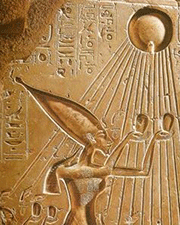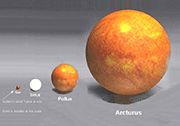E-Archive
Off the Beaten Track
in Vol. 16 - July Issue - Year 2015
Our Great Star

Sun worship in ancient Egypt

400 billion suns in our Milky Way galaxy alone!
Since prehistoric times, the Sun has been recognized as the primary source of life on Earth. Through the ages, civilizations on all continents have attributed divine status to the Sun and have taken great pains to appease the deity through solemn rituals and, at times, human sacrifices.
But what exactly is the great mass at the center of our solar system? The Sun is classified as a G2 dwarf star. When viewed from outer space, its color is white, although the filtering effect of the Earth's atmosphere makes it appear yellow, or at times red or reddish-purple. At its surface, the Sun is composed mostly of hydrogen (74.9%) and helium (23.8%), with metals and other elements (oxygen, carbon, iron, neon, nitrogen, silicon, magnesium and sulphur) making up the balance of less than 2%.
The vital statistics of the Sun are impressive. Its equatorial radius is almost 700,000 km and its equatorial circumference is slightly less that 4.4 million km, both figures being about 109 times greater than the corresponding figures for our planet. The volume of the Sun is 1.3 million times that of the Earth, but the fact that it is composed mostly of gasses means that the mass of the Sun is "only" about 333,000 times greater than that of the Earth.
Although it would be easy to mistakenly consider the Sun as a consistent and uniform mass of gasses, it's actually composed of different layers. At the very heart of the Sun lies the core, which extends from the center to about 25% of its radius. This is where 99% of the Sun's energy is generated through a process of thermonuclear fusion, during which hydrogen is converted to helium. The core has a temperature of almost 15.7 million K and a density about 150 times greater than that of water. Since the next layer is radiative (and not convective), the helium produced during the thermonuclear fusion remains trapped in the core, leading scientists to estimate that the core of the Sun is composed of about 60% helium. Although fusing hydrogen into helium releases only about 0.7% of the fused mass as energy, the sheer size of the Sun means that the thermonuclear fusion in its core releases energy at a mass-energy conversion rate of about 4.26 million metric tons per second.
The layer surrounding the core is called the radiative zone. Energy from the core is transferred to this layer by thermal radiation and the temperature varies from about 7 million K closer to the core to about 2 million K at the furthest point from the center. This zone is also less dense than the core by about a hundred times.
There is a relatively thin transition layer between the radiative zone and the convective zone called the tachocline. It is believed that the Sun's magnetic field is generated in this layer, due to the difference in rotation speeds between the radiative and the convective zones.
The Sun's outer layer is called the convective zone and it extends from the surface to about 200,000 km beneath the surface. Temperatures in this layer are sufficiently low to allow the formation of convective currents. Hotter material from the tachocline has a lower density, causing it to rise to the surface, where it loses heat and becomes denser, thus sinking back down to the radiative zone, where it regains heat and consequently repeats the convective cycle.
The visible surface of the Sun is called the photosphere. It is anywhere from tens to hundreds of kilometers deep and has an average temperature of about 5,800 K, with a very low density of 0.2 g/m3. Energy created in the core ultimately escapes from the photosphere into space in the form of heat and light.
The area above the photosphere is called the solar atmosphere and it is composed of five zones: the temperature minimum zone, the chromosphere, the transition region, the corona and the heliosphere. The temperature minimum zone is found about 500 km above the photosphere and is the relatively coolest part of the Sun's atmosphere, reaching temperatures of about 4,100 K. For reasons that are not yet fully understood, the chromosphere, the transition region and the corona reach temperatures that are tremendously higher than the temperature minimum zone, up to 20 million K, even though they are further from the photosphere. The outermost layer, the heliosphere, is made of solar wind plasma and reaches the very end of our solar system, far beyond the orbit of Pluto.
As impressive as all these statistics are, it has been estimated that there are up to 400 billion stars similar to our Sun in the Milky Way Galaxy alone, with some of these stars being so big that they make our Sun appear as a small dot by comparison!
By Giovanni Gregorat, Contributing Editor MFN
Author: Giovanni Gregorat



























